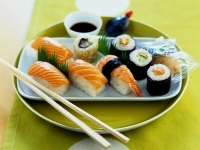Sushi and rolls: tasty, but dangerous? Sushi: the benefits and harms of Asian cuisine
Sushi. So is it good or bad?
The sushi boom in Russia is still over. This is true for many Japanese dish has become no longer exotic, but a familiar part of the diet. But the debate about the benefits and harms of sushi still does not subside. Let's try to answer the most common questions
Question 1. They say there is a lot of mercury in fish. So, is it dangerous to eat a lot of sushi?
Mercury is actually found in some types of fish - including salmon and tuna, which are used in making sushi and rolls. However, to say that there is really a lot of this fish in one serving of sushi would be a clear exaggeration. Believe me, the bulk of this dish consists of rice, vegetables, seaweed and omelette. And even if you eat sushi every day, you won’t eat more than 150 grams of fish in a week. Meanwhile, the upper limit for oily fish consumption is about 600 grams per week. For girls, pregnant and lactating women - half as much.
Compared to what we usually eat for lunch, it's possible. An average serving of rolls contains about 350 kilocalories, and the fat content is quite low - 3.6 g. Please note: only 2 g are so-called saturated fats, which are the cause of high cholesterol. For comparison, a regular hamburger contains about 15 grams of such fat.
Question 3. What harm do they do?
The only dangerous component of this dish is salt. Many believe that soy sauce is almost a healthy substitute for the “white death”. This is wrong. 2-3 teaspoons of sauce can contain up to 1 gram of salt (the daily requirement for an adult is no more than 6 g), so it is better not to overuse this product. If you want something spicy, try replacing it with ginger or wasabi mustard.
Question 4. Rice is a cereal. So, sushi can make you fat?
Theoretically, you can get fat from anything - if you eat it in exorbitant quantities. As for rice, it really is not a low-calorie product. It contains a lot of carbohydrates, and those that are processed almost instantly.
But at the same time, the same sushi contains vinegar, which prevents the absorption of carbohydrates, and spices, which temporarily speed up your metabolism. Consider these effects to cancel each other out.
Question 5: Are sushi and sashimi equally healthy?
No. Sashimi is actually sliced fish fillet. Which, on the one hand, contains a lot of protein and fatty acids, and on the other, again, may contain mercury. So be careful. One sashimi contains half of your weekly requirement.
“Sthenotrophomonos bacteria were discovered in the sea several years ago,” Komsomolskaya Pravda quotes Valery Mikhailov, head of the microbiology laboratory at the Pacific Institute of Bioorganic Chemistry, Far Eastern Branch of the Russian Academy of Sciences. – Their age is about 10 thousand years. We recently completed a study and came to some impressive conclusions. It turns out they could infect a variety of marine organisms.”
According to experts, stenotrophomonas provoke various infections in the human body, such as staphylococcus. And other viruses found in the same waters, such as Compylobacter, lead to stomach ulcers. Bacteria die only when exposed to high temperature. At the same time, chefs working with Japanese cuisine are ready to refute the fears of scientists: “Raw fish and other chilled seafood used in Japanese cuisine are supplied to large establishments only after passing necessary tests. Along with the products, the supplier companies also provide the necessary certificates.” According to the expert, you need to eat sushi or sashimi in the “right” place. “It is better to give preference to well-known chains of Japanese restaurants that have existed in Russia for many years. The products there are always of high quality: strong trade turnover guarantees the freshness of seafood. Besides, The reason for infection of sushi bar customers may not be the dish itself, but the lack of basic sanitary conditions. - says the chef. – Small cafes can purchase cheap products from markets where there is no control at all. There it can be both contaminated and stale.” You can also visit national establishments that are opened by the Japanese themselves. They should also be in order, given that the expansion of Japan’s national cuisine is being decided at the highest level. To appease fans Japanese cuisine, the expert clarified that in preparing dishes, only very frozen fish is most often used (the causative agents of most infections die at a temperature of minus 60 degrees). The fish is then treated with various vinegars that replace the marinade.
 The benefits and harms of sushi and rolls are discussed quite often. Many people nowadays pay tribute to tradition and eat overseas delicacies.
The benefits and harms of sushi and rolls are discussed quite often. Many people nowadays pay tribute to tradition and eat overseas delicacies.
These, without a doubt, should also include sushi, which can consider Japan its homeland.
True, they most likely came to us from the USA and Europe, which was the reason for the linguistic distortion of the true name of the dish. In the original they are available as “sushi”.
Sushi comes in a wide variety of types and shapes. But The main ingredients have always been raw fish (tuna, salmon, eel, salmon), nori seaweed, and rice.
Soybean is used as additives and spices. sauce And wasabi- special Japanese horseradish in a ground state.
So the benefits and harms of a particular type of sushi will depend solely on the ingredients that it contains. So let's start with the most popular ones.
Rice is a healthy source of protein and fiber for our body, which is directly involved in the structure of cells. 
But besides this, we must not forget that an excess of rice in the body leads to an increase in the concentration of carbohydrates, and therefore to unintentional weight gain.
All these are very undesirable factors that many would like to avoid, who naively believe that sushi is food for those who want to lose weight.
Although depending on how you look at it, due to the content of PUFAs (polyunsaturated fatty acids, in particular), sushi and rolls are considered products that normalize weight, strengthen the walls of blood vessels And stabilize heart function.
So let's talk first of all about the benefits of eating sushi and rolls.
Separately, it is worth saying a few flattering words about wasabi. This ingredient should become indispensable because out of all the others applicable to sushi and rolls, it contains the most benefits.
So, wasabi is an excellent antiseptic, which also blocks the development of cancer cells in the stomach and other internal organs. This is in sharp dissonance with one of the disadvantages of sushi in relation to cancer, which we will discuss below.
Raw fish included in sushi contains a lot of phosphorus, which promotes active brain function.
For people who are engaged in active mental activity, it is even more useful to eat sushi from time to time.
It's time to talk a little about the dangers of sushi. The fact that this is an exotic product for our latitudes and not everyone can tolerate it is not the only problem.
If you do not want to become a home for these creatures, then it is best not to overuse sushi, or carefully check the cooking recipes in each specific sushi bar.
After all, many of our recipes have been significantly modified and sometimes you can find “adapted” rolls, filled with lard or meat.
In the case of tuna, there is another important problem. Due to the fact that the world's oceans are significantly polluted, tuna absorbs many harmful substances and especially mercury.
If you don’t want to enjoy sushi and rolls with a fair amount of this substance, then limit yourself to their consumption, at least you don’t need to do it often.
Ask and clarify what kind of fish is used as a filling.
Nori, which is usually wrapped in rolls, contains a lot of iodine. One such roll contains exactly half of the body’s daily intake of this element.
And even though there are many people who treat iodine deficiency in themselves, make sure you don’t have to treat the opposite disease - excess iodine. A fan of this kind of food should seriously consider
They say that excessive consumption of sushi significantly increases the likelihood of developing cancer, in particular liver cancer.
A similar predisposition of exotic food lovers from Japan has not been proven scientifically, but it is still definitely worth warning yourself and taking note of this fact.
Well, how can we not say that, without which it is difficult to imagine sushi, it contains too much concentrated salt.
It accumulates in the body in a fair amount, leads over time to joint problems and even arthritis.
So eat sushi, but don’t forget about the need to strictly dose your consumption of this product! Well, add wasabi don't forget - he is your ally.
The sushi boom has already passed. For many, this Japanese dish has become no longer exotic, but a familiar part of the diet. But the debate about the benefits and harms of sushi still does not subside. Let's try to answer the most common questions .Question 1. They say there is a lot of mercury in fish. So, is it dangerous to eat a lot of sushi?
Mercury is actually found in some types of fish - including salmon and tuna, which are used in making sushi and rolls. However, to say that there is really a lot of this fish in one serving of sushi would be a clear exaggeration. Believe me, the bulk of this dish consists of rice, vegetables, seaweed and omelette. And even if you eat sushi every day, you won’t eat more than 150 grams of fish in a week. Meanwhile, the upper limit for oily fish consumption is about 600 grams per week. For girls, pregnant and lactating women - half as much.
Compared to what we usually eat for lunch, it's possible. An average serving of rolls contains about 350 kilocalories, and the fat content is quite low - 3.6 g. Please note: only 2 g are so-called saturated fats, which are the cause of high cholesterol. For comparison, a regular hamburger contains about 15 grams of such fat.
Question 3. What harm do they do?
The only dangerous component of this dish is salt. Many believe that soy sauce is almost a healthy substitute for the “white death”. This is wrong. 2-3 teaspoons of sauce can contain up to 1 gram of salt (the daily requirement for an adult is no more than 6 g), so it is better not to overuse this product. If you want something spicy, try replacing it with ginger or wasabi mustard.
Question 4. Rice is a cereal. So, sushi can make you fat?
Theoretically, you can get fat from anything - if you eat it in exorbitant quantities. As for rice, it really is not a low-calorie product. It contains a lot of carbohydrates, and those that are processed almost instantly.
But at the same time, the same sushi contains vinegar, which prevents the absorption of carbohydrates, and spices, which temporarily speed up your metabolism. Consider these effects to cancel each other out.
Question 5: Are sushi and sashimi equally healthy?
No. Sashimi is actually sliced fish fillet. Which, on the one hand, contains a lot of protein and fatty acids, and on the other, again, may contain mercury. So be careful. One sashimi contains half of your weekly requirement.
In the so-called Japanese restaurants and sushi bars are always full of visitors. There are more people who like to eat rolls (actually rolls, not sushi, as some people think), although they are not cheap.
Sushi (or “sushi”, as the Japanese themselves call it) became widely known in the world back in the early 1980s. This dish is incomparable to any other fish dish in European cuisine: sushi is distinguished by its unique taste and very delicate texture.
Classic sushi is not subject to heat treatment. Fresh sea fish is used to prepare them. Sushi is most often prepared from tuna, mackerel, salmon or eel, and also from shrimp, octopus, crab and shellfish. It is not customary to prepare sushi from river fish. Sometimes smoked sea fish fillets are used.
The Japanese claim that eating raw fish helps improve health and promotes longevity. In our country, interest in this kind of food is a tribute to fashion, which, oddly enough, came from the West. Yes, precisely from the West, because the fashion for Japanese cuisine swept over Western countries before us and came to the Slavic states from there.
What is sushi and what are rolls
Many people think that these are the same thing. But in reality, rolls differ significantly from sushi both in taste and appearance. They are also prepared in different ways.
Sushi is a traditional Japanese dish made primarily from rice and seafood (sometimes other ingredients are added). These look like ordinary rice cakes, decorated with a piece of fish.
Rolls are a type of sushi, which is also made from rice and fish, but decorated with various vegetables (sometimes fruits) and always seaweed. Externally, the rolls look like pieces of a tightly rolled roll.
In general, sushi and rolls made from quality ingredients can benefit the body.
Sea fish is rich in omega-3 fatty acids, which improve the health of the cardiovascular and digestive systems. In addition, it is these fatty acids that prevent the development of tumor processes in the body. Also, substances contained in fish improve mental activity.
Natural wasabi sauce, with which it is customary to eat sushi and rolls, is an antiseptic and anticoagulant agent.
Rice is another component of the rolls. It is rich in fiber and also aids in the digestion process.
The danger of sushi and rolls
It's not all that simple though. Japanese cuisine is characterized by the absence heat treatment product ingredients. This is where the danger lies in eating rolls. As already mentioned, sushi is made from raw fish. Therefore, the risk of becoming infected with helminths with regular consumption of raw fish fillets increases several times! In Japanese restaurants (those directly in Japan), when using frozen fish, the likelihood of infection with worms is low, since such fish is preserved in compliance with the temperature regime.
Fresh fish is quickly frozen to minus 50 and stored at minus 20 degrees for at least seven days, and defrosted only in cold salt water. It is difficult to say what kind of fish is supplied for making sushi and rolls to Russian restaurants. How long has this product remained unfrozen? What about defrosted? In a matter of hours, pathogenic bacteria develop in fish without freezing. Famous catering establishments must keep certificates for the products from which sushi and rolls are prepared. With the proliferation of small sushi bars that offer Japanese dishes at very low prices, rolls have become more accessible. However, conclusions can be drawn about the quality of the raw materials in such places. It must be said that doctors in our country noted that lovers of Japanese cuisine were infected with worms. Such cases can hardly be called frequent, but nevertheless they do occur.
Doctors warn lovers of sushi and rolls against frequent consumption of tuna meat and other long-lived species of predators that live in the sea. Such products contain high concentrations of mercury and heavy metals.
Previously we talked about the benefits of wasabi sauce. Natural wasabi is the rhizome of Japanese horseradish, ground to a powder. Making real wasabi is expensive. Therefore, wasabi is prepared by adding dyes, spices and flavors to more accessible varieties of horseradish. Doctors advise to beware of such “counterfeits”.
Soy sauce seasoning sushi and rolls is also unsafe. It contains a large amount of salt, so you should not abuse it. Excess salt in the human body can cause swelling. For hypertensive patients, consuming large amounts of salt can provoke a hypertensive crisis.
In addition, salt has the ability to accumulate in joints. One or two tablespoons soy sauce contain up to 2 g of salt, with daily norm its consumption is 5-8 g.
Often, Philadelphia cheese, which is a type of cream cheese, is added to rolls in our country (these rolls are called “Philadelphia”). This industrially prepared product contains stabilizers, preservatives and flavorings to preserve taste and increase shelf life. Chemicals are another point in the harm column of rolls.
Sushi rolls are prepared mainly from white rice, which has a high glycemic index, that is, it is high in calories and is not entirely suitable for those who want to lose weight. Therefore, obese people should consume this food in moderation, knowing their own calorie needs. In general, the calorie content of rolls depends on what they are stuffed with.
Homemade rolls
It is quite possible to prepare your own rolls, ridding the dish of harmful ingredients. To prepare rolls at home, it is better to take sea fish, which is found in our latitudes. Fresh fish is rich in proteins, minerals (potassium, phosphorus, zinc), B vitamins and fatty acids. Substances contained in sea fish improve mental activity and normalize the functioning of the digestive and cardiovascular systems. But the longer the fish is stored, the less useful it remains. Therefore, if you decide to cook rolls and bought sea fish for this, do not delay cooking for too long.
Of course, our homemade “Russian rolls” are not at all like the rolls in Japanese restaurants. But in general, this is not bad. Why not sometimes diversify your table with an interesting Japanese dish in the Russian style, and even prepared yourself. In addition, it is not necessary to eat rolls with chopsticks, as is customary in their homeland. You can experiment with the ingredients of the rolls and even make them completely “Russian” by wrapping the filling in pancakes. You can make rolls with river fish, smoked or salted. You can fry and bake rolls, or you can use lean foods - vegetables and fruits - for cooking. This homemade dish is perfect for the Lenten table if the family’s personal holidays fall during Lent. However, we remind you that fasting is a time for the simplest food possible. Probably, what really should be learned from the Japanese during fasting (and not only during fasting!) is moderation in everything, including food.
Be healthy!
The most popular Japanese dish is, of course, sushi. But besides sushi Japanese menu There are many other terms whose meaning can easily get lost. How, for example, do sushi, rolls and sashimi differ from each other? You can order each type of dish on www.fresh-sushi.ru and figure it out yourself. Another option: read this article and find out in advance which of these dishes will be to your liking.Rice is the head of everything
The fundamental ingredient of Japanese cuisine is rice. All dishes that consist of portioned pieces of fish with rice are called sushi. There are more than a dozen varieties of them. The most famous in Russia are nigiri and maki; any sushi delivery service offers them.
Nigiri sushi is a lump of rice with a piece of raw or cooked fish or other seafood on top. Sometimes nigiri sushi is tied with a thin strip of noria seaweed.
Maki sushi is better known by its English name “rolls” (from the English roll - to roll). The process of making maki sushi begins with rolling rice and filling using a mat. The finished roll is cut into portions.
Sashimi differs from sushi in that it does not contain the most important thing - rice. Sashimi is essentially just chopped seafood. It's so simple and unpretentious.
How to eat sushi, rolls and sashimi?
1. Severe Japanese samurai can afford to eat sushi and sashimi simply with their hands, but eating it with European cutlery is absolutely not comme il faut. The best way to learn to eat is with chopsticks. By the way, girls have no choice at all.
2. Serving sushi and sashimi always includes soy sauce and wasabi. Properly pour a little soy sauce into a cup and stir a small amount of wasabi in it. Too much wasabi will kill the flavor of the dish.
3. Each piece of sashimi should be dipped in the sauce before putting it in your mouth. The same should be done with sushi. Since rice that has absorbed the sauce quickly loses its shape, nigiri sushi should be dipped into the sauce with fish. To do this, first turn the sushi on its side on the plate with chopsticks, and then start eating.
4. Sushi is made so small that you can put it whole in your mouth. Try not to bite into the sushi. Firstly, they will most likely fall apart, and secondly, you will not feel the whole bouquet of taste.
5. Pickled ginger should be eaten between different types sushi. This way the taste of the first dish is removed and the second one can be tasted in all its glory.
Popular
- On a dice, the sum of points on each pair of opposite faces is the same
- Premature aging
- Program of nursing process in the work of paramedical workers in family offices on health-saving behavior for specialties Women's consultation conversations with mothers
- How to preserve food without refrigeration How to preserve chicken without refrigeration
- Stylish hats for women
- Dmitry Gordon: “Sometimes I take five or six interviews a day!
- Bamboo health. All products. Indications and prohibitions
- Miroslava Gongadze: “George’s children do not receive anything from the project of the life and death of their father
- Victoria Brezhneva: biography and photos Autobiography of Galina Brezhneva
- Vitamins and dietary supplements: Supplements for clear skin Collagen is found mainly in meat and fish




